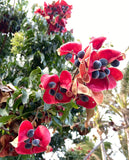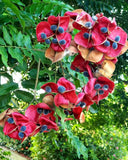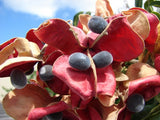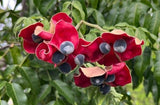Majidea zanguebarica Seeds
A Botanical Jewel from East Africa
Imagine a tree whose very name whispers of majesty and heritage. Majidea honors Majid bin Said, the first Sultan of Zanzibar, placing this species in the rich tapestry of Zanzibar’s history and culture.
Native to East Africa’s coastal forests—Kenya, Tanzania, Zanzibar—this species is sometimes called the Mgambo Tree, a Swahili word meaning “announcement” or “proclamation.”
Ornamental Elegance & Botanical Drama
Growing typically up to around 5 m (16 ft) tall, though forest specimens may reach lofty heights, it features a glossy, compound canopy that evokes sophistication and tropical elegance.
Blooming in dense clusters of small green-red (sometimes orange-tinged), delightfully fragrant flowers at panicle ends, it not only pleases the eye but also enchants the air with its scent.
When the fruit matures, it dramatically splits open to flaunt a brilliant scarlet interior, inside which nest three velvet-soft, obsidian blue-black seeds—the tree’s “pearls.”
These stunning seeds inspire awe—and artisan intrigue, often used in handcrafted jewelry, potpourri, and floral arrangements.
Hardiness, Growth & Care
-
USDA Hardiness Zones: 9–11, making it a tropical beauty best suited to frost-free climates. For cooler regions, it thrives as a container plant or charming bonsai.
-
Light & Soil: Prefers full sun, moderate water, and well-drained rich soil, slightly acidic where possible.
-
Drought Tolerance: Once established, it exhibits a fair degree of drought resilience, making it both hardy and low-fuss.
Cultural & Artistic Significance
Beyond botanical charm, Majidea zanguebarica is deeply woven into artisanal and cultural practices. The seeds—resembling soft, velvety pearls—are revered in East African jewelry making, while the dried capsules and pods bring radiant color to bouquets and potpourri worldwide.
Wildlife & Ecological Notes
While there’s no specific record of butterflies, moths, or other wildlife using Majidea zanguebarica as a larval host or food source, its fragrant flowers are noted to attract butterflies, offering a subtle nod to its ecological allure.
Intriguing Tidbits
-
Occasionally found naturalizing in places like Hawaii, it has shown adaptability beyond its native realm—yet remains largely non-invasive.
-
Its wood is valued locally for quality and is sometimes harvested for trade—not just treasured for its seeds.
Description Highlight for Listings
Majidea zanguebarica – Black Pearl Tree Seeds
Step into a realm where culture, elegance, and nature intertwine. Each seed holds the legacy of Zanzibar’s first Sultan, moss-soft and blue-black as night, waiting to unfurl its beauty. Grow a tree that blooms with fragrant emerald-rose clusters and bares fruit like a dramatic ruby-lined treasure chest. Ideal for USDA zones 9–11 or as a poetic bonsai centerpiece elsewhere. Though it may not be a wildlife host per every record, its blooms beckon butterflies—soft whispers of life in your garden. Make jewelry of artful seeds, style dried pods into glowing bouquets, and cultivate heritage, fragrance, and wonder—all from these few sacred seeds.










